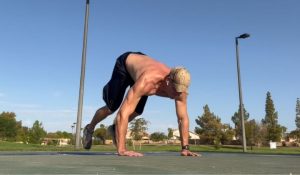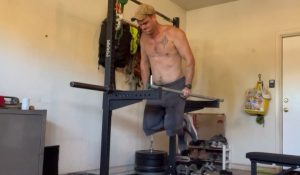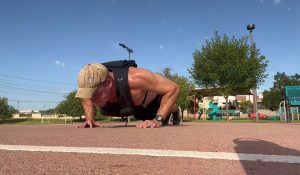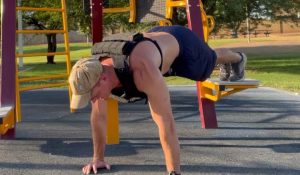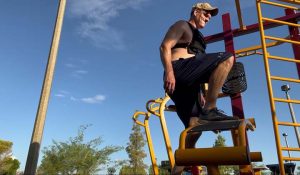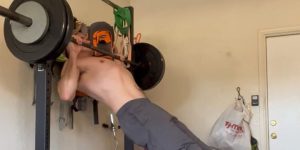It’s well known that face pulls are one of the best exercises for strong and healthy shoulders that look as good as they perform. By doing face pulls with a resistance band, we can have access to this functional and scalable exercise everywhere we go!
The resistance band face pull is a strength-training exercise that targets the shoulder and upper back muscles. This exercise involves pulling a resistance band towards the face while keeping the elbows high and out to the sides. It is a great exercise for people looking to improve posture, reduce shoulder pain, and increase upper body strength. It can also be beneficial for athletes and individuals engaging in physical activities that require upper body strength.
Read on to discover the full potential of resistance band face pull and how it can fit into a daily fitness practice.
How to do resistance band face pulls
If you’ve ever done a regular free weight or cable face pull, this exercise will be familiar to you. In case you haven’t, here are some pointers on how to do it for maximum benefit:
- Start position can either be seated or standing. If you prefer standing, wrap the resistance band around a door handle or pole. If you prefer seated, wrap the resistance band around your feet.
- Sitting or standing with a straight back, grasp both ends of the band with each hand, and pull the slack out of the band.
- Leading with your elbows, pull the ends of the band up towards the side of your head, pinching the shoulder blades together as you pull.
- For maximum benefit, pause at the end of the range of motion. The end position should resemble a bodybuilder’s “double bicep” pose:

- Release the band slowly, over 2-3 seconds. The shoulders are notoriously fatigue resistant and respond well to being tired out with slow eccentrics.
How to program face pulls
Face pulls, in general, are an exercise that responds to high repetitions. While you want to pick a level of resistance that will challenge you, you also don’t need to be that guy who tests your five-rep max on face pulls.
I recommend living in the 15-30 rep range on face pulls. This will allow you to get a good amount of blood flowing through the muscles and a good training stimulus. Continue performing reps until you reach about 1-3 reps from muscular failure.
For our purposes, we will define “muscular failure” as the point at which we can no longer hold a one-second pause at the end of the range of motion. If you reach this point, stop the set.
As with most exercises, completing 10-20 work sets per week on the exercise should provide maximum benefit. Split them up however you wish – the simplest option would be to simply do two sets per day, Monday through Friday.
However, they superset well with other exercises and they also lend themselves to time-efficient techniques like myo reps, so it shouldn’t be tough to sneak them in.
Benefits of doing face pulls with resistance bands
Your shoulder health will thank you
Face pulls are famous for their ability to prehab shoulders by virtue of the fact that they work the often neglected small muscles of the rotator cuff directly.
If you’ve got cranky shoulders, some face pulls every day can go a long way toward rebuilding functional shoulders.
They can be safely done every day
Face pulls done with a resistance band can be done every day. One of the benefits of resistance bands is that they don’t tend to create a lot of muscle soreness, since the resistance band lessens as the band is stretched.
This means that a few sets of face pulls done with a resistance band can easily fit into a daily routine without fear of overtraining muscles or incurring injury.
They naturally counteract postural deficiencies
Though the virtues of “perfect” posture get continually oversold, it’s no secret that most of us spend our days hunched over computer keyboards, cell phones, and steering wheels.
Face pulls in general are a great way to utilize and build some forgotten musculature in the shoulders and upper back. What’s more, using a resistance band (as opposed to a cable machine or barbell) allows us to perform face pulls wherever we go.
You’ll look better
Regardless of your goal, a little aesthetic benefit never hurt anyone, right? Face pulls are notorious for building out the musculature in the lateral and rear delts, in addition to the upper trapezius. Regardless of your gender, age, or fitness goals, you will almost certainly look better if you build muscle in these areas.
As they say, “Traps are the new abs!”
Muscle groups worked by the band resisted face pulls
Face pulls do a great job of targeting some notoriously neglected muscles:
- Lateral deltoids and rear deltoids
- The upper portion of the trapezius
- The small muscles of the rotator cuff: supraspinatus, infraspinatus, teres minor

A word of caution
A simple Google search for resistance band injuries will return numerous results from people who have snapped resistance bands and received an unwelcome welt somewhere on their body.
While this may be an unpleasant experience most of the time, it should go without saying that an exercise called the face pull may call for some extra caution along these lines!
Resistance bands can and do wear out over time. That being said, I’ve never personally had a problem – they usually show some cracking for quite a while before they fully give up the ghost and snap.
Just check your resistance band every couple of days, specifically in the spots that bend around your feet or uprights when you do your exercises (typically in the middle of the band).
As long as your resistance band isn’t showing wear, you should be good to go. If you see that the band has some cracking around the middle, it’s probably time to replace it.
After all, these things aren’t expensive!
Final Word
Whether you’re looking to fix cranky shoulders, improve posture, or give your shoulder muscles an aesthetic boost, face pull exercise is a great way to do it. When you perform the exercise with resistance bands, it becomes all the more accessible. Give it a try!






